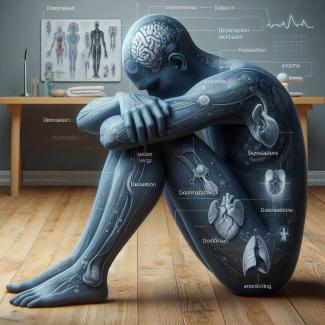
Depression is a prevalent and multifaceted mental health condition characterized by a persistent feeling of sadness or a loss of interest in activities once enjoyed. It affects millions globally, impacting daily functioning, emotional well-being, and overall quality of life. This comprehensive guide delves into the intricacies of depression, examining its symptoms, types, diagnostic tests, and treatment options. By exploring specific studies and research, we aim to provide a thorough understanding of this complex disorder and outline effective strategies for management and recovery.
Symptoms of Depression
Depression manifests through a variety of symptoms, which can differ in severity and duration among individuals. According to the Diagnostic and Statistical Manual of Mental Disorders, Fifth Edition (DSM-5), common symptoms of depression include:
- Persistent Sadness or Low Mood: Individuals often experience a pervasive sense of sadness or emptiness that persists for most of the day, nearly every day.
- Loss of Interest or Pleasure: A noticeable decrease in interest or pleasure in activities that were previously enjoyable, such as hobbies, social interactions, or work-related tasks.
- Significant Weight Change: Marked weight loss when not dieting, or weight gain, often accompanied by a change in appetite.
- Sleep Disturbances: Insomnia or excessive sleeping (hypersomnia) can be prevalent, impacting overall energy levels and mood stability.
- Fatigue or Loss of Energy: Persistent tiredness or lack of energy, even after adequate rest, which can affect daily functioning.
- Feelings of Worthlessness or Guilt: Excessive or inappropriate guilt, self-blame, or feelings of worthlessness that are disproportionate to actual events.
- Difficulty Concentrating: Impaired cognitive functioning, including trouble concentrating, making decisions, or remembering details.
- Thoughts of Death or Suicide: Recurrent thoughts of death, suicidal ideation, or attempts, which are serious and require immediate professional intervention.
Studies such as the National Comorbidity Survey Replication (NCS-R) highlight that depression can vary significantly in its presentation and severity. The American Journal of Psychiatry reports that up to 20% of individuals will experience a major depressive episode at some point in their lives, underscoring the widespread nature of this condition.
Types of Depression
Depression can be classified into several types, each with distinct characteristics and diagnostic criteria:
- Major Depressive Disorder (MDD): Characterized by the presence of one or more major depressive episodes lasting at least two weeks. Symptoms must represent a change from previous functioning and cause significant distress or impairment. MDD is one of the most studied forms of depression, with research from the Journal of Clinical Psychiatry indicating a prevalence rate of approximately 6-7% in adults annually.
- Persistent Depressive Disorder (PDD): Formerly known as dysthymia, PDD involves a chronic form of depression lasting for at least two years. Individuals with PDD experience a consistently low mood, with symptoms being less severe but more enduring than those of MDD. Research in the Journal of Affective Disorders suggests that PDD affects about 1.5% of the population annually.
- Bipolar Disorder: Characterized by alternating episodes of depression and mania or hypomania. The depressive episodes in bipolar disorder can closely resemble those of MDD, but are interspersed with periods of elevated mood. The Bipolar Disorder Study Group indicates that bipolar disorder affects about 1-2% of the global population.
- Seasonal Affective Disorder (SAD): A type of depression that occurs at specific times of the year, usually in the winter months when daylight hours are shorter. The American Journal of Psychiatry estimates that SAD affects around 0.5-3% of individuals in temperate climates.
- Postpartum Depression (PPD): A severe form of depression occurring after childbirth. Unlike the typical "baby blues," PPD can significantly impair a mother's ability to care for herself and her baby. Research published in JAMA Psychiatry indicates that PPD affects approximately 10-15% of new mothers.
- Psychotic Depression: A subtype of major depression where individuals experience psychotic symptoms such as delusions or hallucinations. According to the Journal of Clinical Psychiatry, about 10-20% of individuals with major depression may also exhibit psychotic features.
Diagnostic Tests for Depression
Diagnosing depression involves a comprehensive evaluation that may include:
- Clinical Interview: A detailed interview with a mental health professional to assess symptoms, duration, and impact on daily functioning. Tools such as the Structured Clinical Interview for DSM-5 (SCID-5) are commonly used.
- Self-Report Questionnaires: Standardized questionnaires to evaluate the severity of depressive symptoms. Examples include:
- Beck Depression Inventory (BDI): Measures the severity of depression through a series of questions about mood, behavior, and physical symptoms.
- Hamilton Rating Scale for Depression (HAM-D): Assesses the severity of depression based on clinician-administered questions.
- Psychological Testing: Additional tests may be used to assess cognitive functioning, emotional states, and personality traits. The Minnesota Multiphasic Personality Inventory (MMPI) is one such test.
- Laboratory Tests: While no specific lab tests diagnose depression, blood tests may be conducted to rule out other medical conditions that could mimic depressive symptoms, such as thyroid disorders or vitamin deficiencies.
- Neuroimaging: Brain imaging techniques, such as MRI or PET scans, are used in research settings to study brain abnormalities associated with depression. Studies like those published in Biological Psychiatry have found structural and functional differences in the brains of individuals with depression.
Treatment Options for Depression
Treatment for depression often involves a combination of approaches tailored to individual needs. The main treatment modalities include:
- Pharmacotherapy: Antidepressant medications are commonly prescribed to manage depression. Key classes of antidepressants include:
- Selective Serotonin Reuptake Inhibitors (SSRIs): Increase serotonin levels in the brain. Examples include fluoxetine (Prozac) and sertraline (Zoloft). Research published in JAMA Psychiatry shows that SSRIs are effective in reducing depressive symptoms and are generally well-tolerated.
- Serotonin-Norepinephrine Reuptake Inhibitors (SNRIs): Increase both serotonin and norepinephrine levels. Examples include venlafaxine (Effexor) and duloxetine (Cymbalta).
- Tricyclic Antidepressants (TCAs): Older class of antidepressants that are effective but have more side effects. Examples include amitriptyline and nortriptyline (Pamelor).
- Monoamine Oxidase Inhibitors (MAOIs): Affect serotonin, norepinephrine, and dopamine levels. Examples include phenelzine (Nardil) and tranylcypromine (Parnate).
- Psychotherapy: Also known as talk therapy, psychotherapy can help individuals understand and manage their depression. Common types include:
- Cognitive Behavioral Therapy (CBT): Focuses on identifying and changing negative thought patterns and behaviors. Studies in Behaviour Research and Therapy show CBT to be effective in reducing depressive symptoms and preventing relapse.
- Interpersonal Therapy (IPT): Addresses interpersonal issues and improves communication skills. Research in American Journal of Psychiatry supports IPT’s efficacy in treating depression.
- Psychodynamic Therapy: Explores underlying emotional conflicts and past experiences. Research in Journal of the American Psychoanalytic Association indicates that psychodynamic therapy can be beneficial for certain individuals.
- Lifestyle Changes: Incorporating regular physical exercise, a healthy diet, and good sleep hygiene can significantly impact mood and overall well-being. Studies in The Lancet Psychiatry have demonstrated that physical activity can improve symptoms of depression and enhance the effectiveness of other treatments.
- Alternative Therapies: Techniques such as mindfulness meditation, acupuncture, and yoga may offer additional support for managing depression. Research published in Complementary Therapies in Medicine suggests that these therapies can complement traditional treatments and improve mental health.
- Electroconvulsive Therapy (ECT): ECT is a medical procedure used to treat severe depression, especially when other treatments have failed. Research in Biological Psychiatry shows that ECT can be highly effective for treatment-resistant depression, though it is generally considered a last resort due to its invasive nature.
- Transcranial Magnetic Stimulation (TMS): A non-invasive procedure that uses magnetic fields to stimulate nerve cells in the brain. Studies in Journal of Clinical Psychiatry have shown TMS to be effective in reducing symptoms of depression, particularly for individuals who have not responded to medication.
Depression is a complex and multifaceted condition that affects a significant portion of the global population. Understanding its symptoms, types, and treatment options is crucial for effective management and recovery. By incorporating evidence-based research and clinical practices, individuals and healthcare providers can work together to address depression comprehensively and enhance overall well-being. Whether through pharmacotherapy, psychotherapy, lifestyle changes, or alternative therapies, a personalized approach to treatment can offer hope and support to those affected by this challenging mental health condition.






